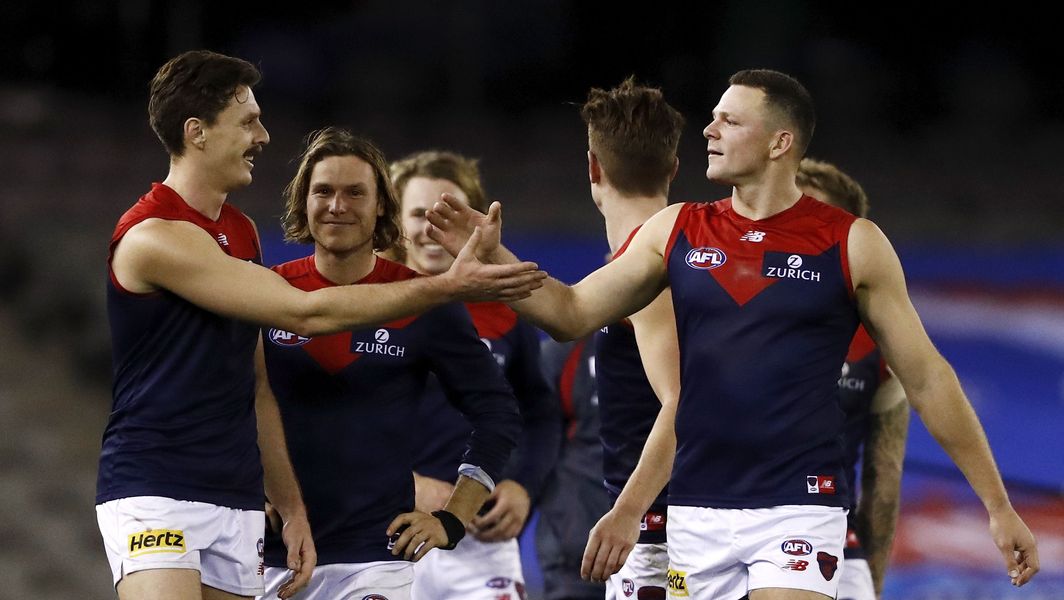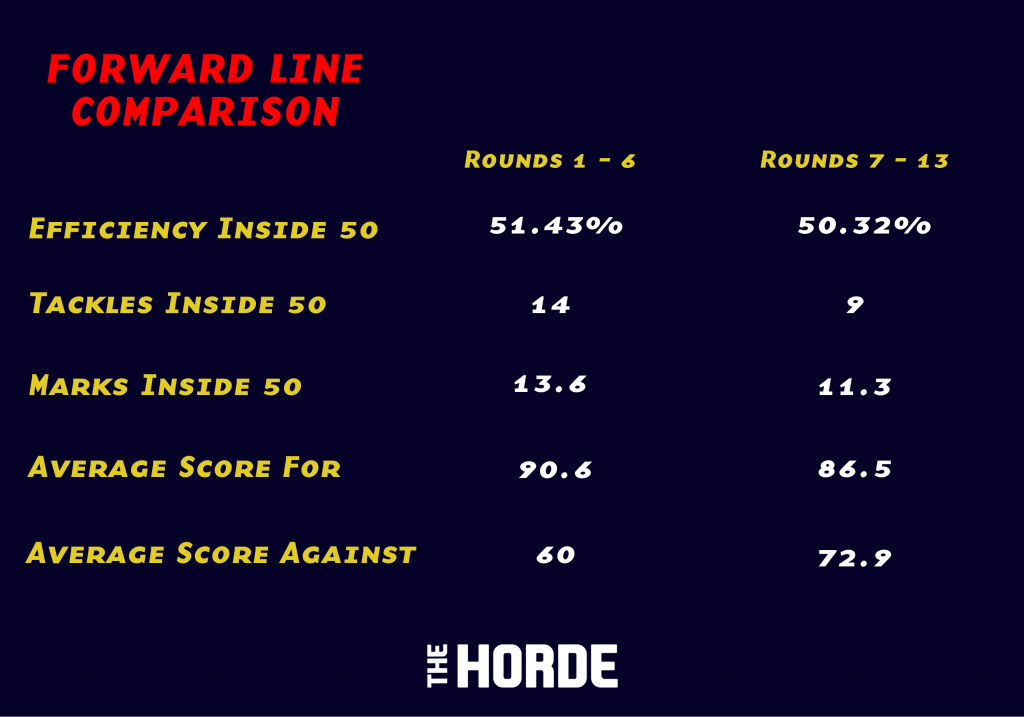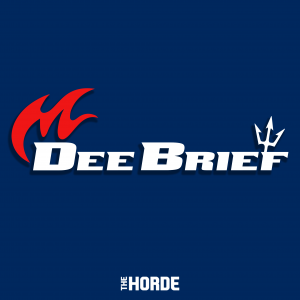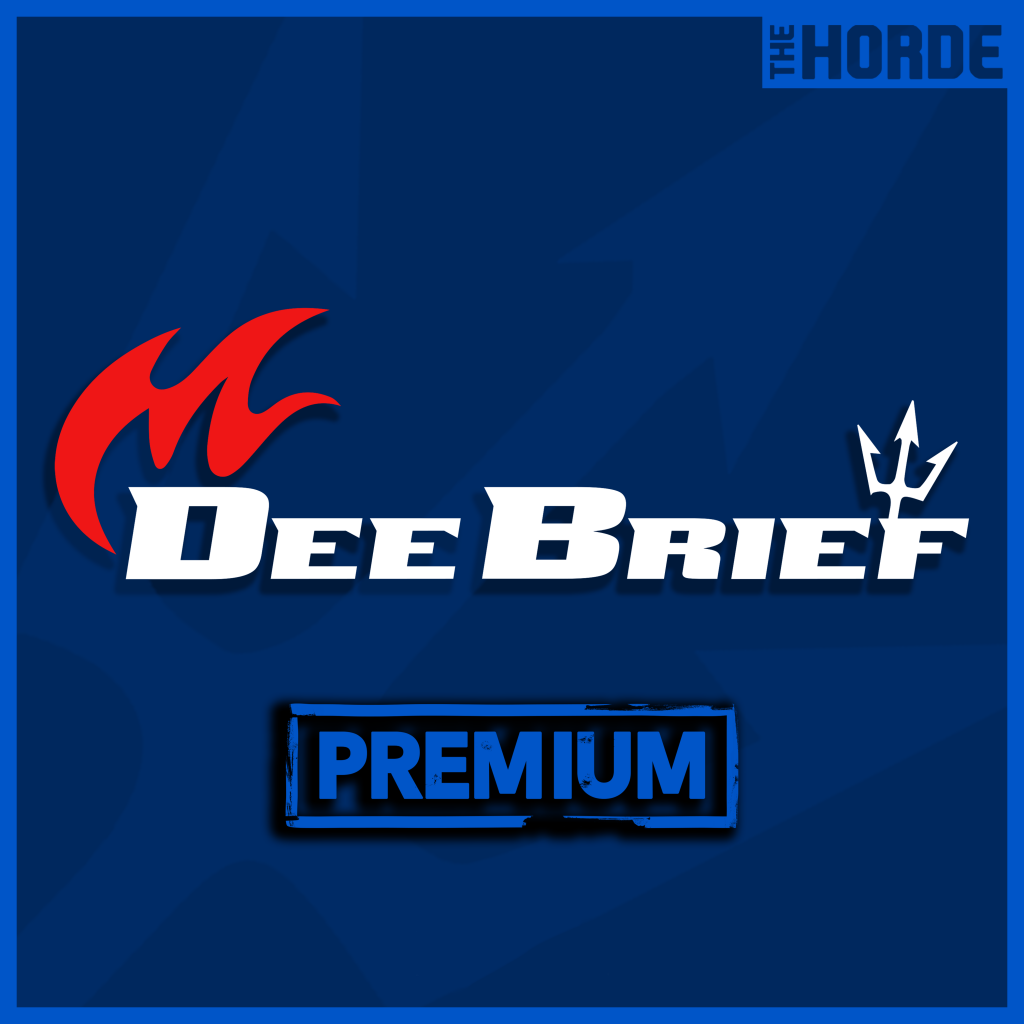
Dees’ conundrum in second half of 2021
It’s been a whirlwind 2021 for Melbourne supporters.
The fanbase have suffered more than arguably any other club in the competition over the past century.
They went through a 23-year finals exodus from 1965 to 1987. Constantly featured in September from the late 80s into the early 90s under John Northey. Endured a near merger with Hawthorn, but then railed under the ‘Reverend’, Neal Daniher and always punched above their weight.
The club plummeted into a dark spiral between 2008 – 2013; many who are still scarred by the experienced. And their two Grand Final appearances since the last flag in 1964 amounted to a 96-point thumping at the hands of Hawthorn and a 10-goal hiding by a dominant Essendon in 2000.
It’s been slim pickings for the red and blue faithful.
You wouldn’t dare mention icon of the game, Jim Stynes’ infamous running through the mark incident in 1987 – apologies to the older generation – which still haunts Melbourne tragics.
Right now, though, their win loss record reads: 11 wins, 2 losses. Top of the ladder and boasting a 5-0 record against top eight opposition. Western Bulldogs, Geelong, Sydney and Richmond have all been seen off by an average winning margin of 23.6 points. Comfortable victories for the most part, despite being challenged in different periods of those matches.
Finally, the supporters can dare to dream. Dare to believe without any hesitation, right? Not exactly.
Unexpected losses to lowly Adelaide and Collingwood proved timely reminders of the AFL’s ultra competitive nature. That, and Melbourne’s supposed ‘fragility’, which opposition fans love to goad us with and admittedly puts Demons on edge; even in heady times like this when you consider the strong inroads made.
Mental and physical fatigue was bandied about in the aftermath of the Queen’s Birthday defeat to heal collective wounds. Yet one aspect cannot be excused so flippantly – Melbourne’s forward line setup.
Before we deep dive into the inner workings of Simon Goodwin and the coaching staff’s structure in the forward half, let’s indulge in what’s functioning exceptionally well for Melbourne.
Marshalled by imperious duo Jake Lever and Steven May, the Dees have become a difficult team to score and move the ball against.

Lever and May are starting to pay huge dividends for the Dees
Melbourne are the league’s premier defence. They concede a goal only 19.04% of the time it enters their defensive 50 – averaging a paltry 67 points against per game.
It’s a buy-in from every player on the ground, the way they guard space and hold their position to force teams high and long down the line. The sacrificial, gut-running role of Angus Brayshaw and his more prolific ball-winning counterpart Ed Langdon have supported the back six superbly – epitomising Melbourne’s defence first approach.
The hefty financial investments of Lever and May have become completely justifiable, after finally getting continuity together. Both players, along with Salem, are rightly in All-Australian calculations. The latter is calm and composed with ball in hand, developing his game to become somewhat of a quarterback for the team. Moreover, he’s making the whole argument of relinquishing pick 2, which GWS used for Josh Kelly, in favour of himself and Jayden Hunt look more vindicated with every passing game.
Lauded early in his career for his marauding runs and his colourful headband, Hunt is revitalised after years of being thrown all over the ground. Back in his natural defensive habitat he’s simplified his game, understanding his kicking limitations, but knowing when to hold his position, beat his man and when he has licence to roam. Along with counterpart, Michael Hibberd, who has done a number of big lockdown jobs, including a succesful assignment on the competition’s best player of the past four years, Dustin Martin, the pair play an understated ‘role’ for the team.
And the timing of Trent Rivers’ arrival has been opportune, playing beyond his years, as ageing and fan-favourite Neville Jetta enters the twilight of his career. Despairingly Adam Tomlinson, who was ranked the best one-on-one defender for the first six rounds, succumbed to an ACL injury in Round 7. His replacement Harrison Petty has been steady, particularly given he’s only played 18 senior matches to date.
Of the previous 10 premiership sides, eight were in the top 4 teams for least points conceded in the home and away season. The only exception? Hawthorn in 2013 were fifth for points against and sixth in 2014, respectively. They did, however, rank 1st for points scored in those two successful campaigns – they gave up a little defensively to maximise scoring.
In the midfield Clayton Oliver (ranked 1st for contested possessions) and Christian Petracca (ranked 4th for score involvements) have elevated themselves to become one of the most dangerous midfield combinations in the competition. Despite their dominance the Dees are ranked 11th for clearances, but have been able to stem this in general play as the third best contested possession team.
The impending return of Jack Viney will undoubtedly enhance Melbourne’s ball winning capabilities out of the middle, while James Jordon’s breakout year and James Harmes’ rejuvenation after two average years have the team well stocked in the midfield department.
With the sixth oldest list and 9th in terms of games experience, the demographic of Gooodwin’s squad is well placed in the premiership window.

Luke Jackson is one of the favourites for the Rising Star award
Comparisons are being made with other premiership outfits, and rightfully so. The one that’s almost the most aligned to Melbourne’s plight is the Geelong outfit of 2007. Like the Dees, they had all the talent in the world. But for years, they struggled to build a consistent, winning brand of footy.
In Mark Thompson’s first seven years, they were topsy turvy. The first year they finished a respectable 5th, only to be bundled out of finals in Week 1 by arch rivals Hawthorn. The following season the Cats fell to 12th, rose to a frustrating 9th in 2002 and then reverted back to 12th in 2003. They were in no man’s land.
But, a season of pressure on the coach saw them bounce back in 2004. They came within a whisker of making the Grand Final, losing out to reigning three- time premiers Brisbane in a Preliminary Final nail-biter.
Yet despite many believing they had all the ingredients to go one better the next season, they capitulated against Sydney in a dramatic semi-final. Thompson’s tenure looked all but over in 2006 when Geelong missed the finals. After seven years in the top job, even the supporters felt the writing was on the wall for the former Essendon champion.
However, much like Melbourne’s recent off-season, the club’s board stuck by their man. One final chance to prove his worth, and ‘Bomber’ delivered. In the process Geelong broke a 44-year drought in 2007, their previous triumph at the time 1963 – a year before Melbourne’s most recent.
It took Mark Thompson eight years to scale the mountain. Damien Hardwick, did it in his seventh year. Mark ‘Chocco’ Williams, now an influential assistant with the Demons, achieved the ultimate goal in six years, after years of nearly misses.
If you look at Melbourne’s grand plan, including Paul Roos’ rebuild, this a continuation under Goodwin that now sits in its eighth year. And keep in mind, Melbourne were coming from much further back than the aforementioned clubs. The talent pool was extremely threadbare and required an extensive overhaul at the draft and through trading.
For all praise of the Dees’ ‘system’, the one glaring problem that must be solved before finals is the forward half. It’s the never-ending debate for supporters at the moment, yet a healthy one, given other elements of the game plan seem assured.
The Dees are ranked 8th in the league for a goal kicked every time it enters forward 50 at 23.12%, which has been blighted by poor inaccuracy throughout the year.
Regardless, the coaches are still doing their homework on what system suits best. It begs the question; should the Demons go tall or small up forward?
In the first six rounds Melbourne opted for a smaller, more mobile forward line setup – with the exception of Mitch Brown’s inclusion in Round 5 against Hawthorn.
Pre-season setbacks to recruit Ben Brown and sixth-year forward, Sam Weideman forced the coaches to put their faith in Tom McDonald as the focal point of attack.
He was ably supported by medium sized forward Bayley Fritsch, with Alex Neal Bullen, Charlie Spargo and Kysaiah Pickett applying forward half pressure and getting involved in scoring chains.
Depending on ruck duties, Max Gawn or Luke Jackson would rotate through the forward line and Petracca continues to provide a strong option when called upon.
On paper before Round 1 it looked slightly impotent. Six weeks later and that viewpoint was completely reversed.
In Round 7 we saw the introduction of Ben Brown against former side North Melbourne. He managed two goals in a relatively quiet afternoon. A week later and three goals against Sydney in a low-scoring affair proved decisive in the overall result.
But then in Round 9 against Carlton, Weideman and Brown shared a forward line. The end result between them amounted to zero goals and minimal impact.
The coaching staff then put their faith in Weideman, dropping Brown. After five matches that persistence in Weideman equated to just 3 goals.
With rumours circulating Brown has been undergoing a ‘mini pre-season’ and Weideman almost destined for the chopping block, it could be an opportune time to revert to the original forward line makeup.
The stats don’t lie.

Melbourne have proved to be more effective with a smaller setup.
– They are more efficient inside 50
– Lay considerably more tackles inside 50
– Take more marks inside 50
– Kick a marginally bigger score
– And concede over two goals less per match
Goodwin has built a contested brand since the day he took the reins. Being the No. 1 tackling team is no surprise, with the Dees’ objective to pen the ball in their forward half and create repeat opportunities.
With five less tackles and effectively 13 points more points conceded on average per game, with the taller setup, Melbourne’s ‘defence first’ system could be compromised.
It’s a conundrum that will have been mulled over incessantly by the coaching department during the bye round.
Stay the course with the current makeup or default back to the early season mix?
With nine matches left, it’s a decision which could ultimately prove the difference between a top 4 spot or not.
Subscribe and become a Premium DeeBrief member to access exclusive Dees content and support the our podcast.





Damian Rodbard-Bean
Like the analysis fellas. It’s obviously the most important part of the puzzle that MFC are grappling with.
Here’s my take: I imagine the coaching staff are trying to create multiple versions of their forward structure (3), with different personnel slated for different roles depending on opponent, conditions, venue etc. The next 5-7 rounds will complete the experimentation process which will identify the best players for each structure with backups as required.
If it were three different structures, they would be 1. tall, 2. small, and 3. hybrid.
The players that are jostling for these places would be chosen according to the variables mentioned. Think.. weed, ben b, mitch b, harmes, Jones, melksham, daw will be rotated through the forward lineup according to weekly variants.
I think tmac, fritch, spargo, pickett, anb and dogga (bench /ruck swing) pick themselves.